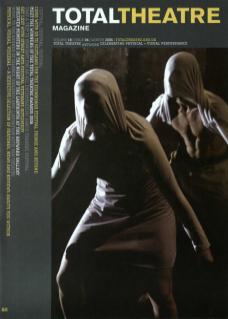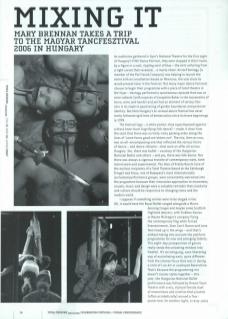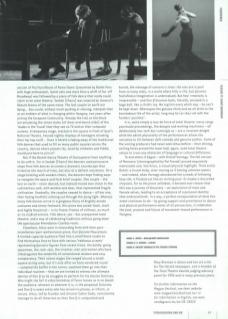As audiences gathered in Gyor’s National Theatre for the first night of Hungary’s Fifth Dance Festival, they were stopped in their tracks by a figure in a vast, rippling swirl of blue – the skirt unfurling from a tight corset that revealed... a manly chest. Kristof Varnagy (a member of the Pal Frenak Company) was helping to launch the event with an installation based on Mennono, the solo show he would present later in the Festival. Not many major dance festivals choose to begin their programme with a piece of total theatre in the foyer – Varnagy performed a spontaneous episode that was at once cabaret (with nuances of Josephine Baker in the movements of torso, arms and hands) and yet had an element of serious theatre in its implicit questioning of gender boundaries and personal identity. But then Hungary’s bi-annual dance festival has never really followed rigid lines of demarcation since its brave beginnings in 1998.
The festival logo – a white pointe-shoe superimposed against a black knee-boot (signifying folk dance) – made it clear from the start that there was no hoity-toity pecking order along the lines of ‘some forms good art/others not’. The mix, then as now, was an all-encompassing one that reflected the various forms of dance – and dance-theatre – that were on offer all across Hungary. Yes, there was ballet – courtesy of the Hungarian National Ballet and others – and yes, there was folk dance. But there was always a vigorous tranche of contemporary work, both mainstream and experimental. The likes of Yvette Bozsik (one of the earliest recipients of a Total Theatre Award at the Edinburgh Fringe) and Artus, one of Budapest’s most internationally acclaimed performance groups, were consistently welcomed into the programme because their innovative approaches to movement, visuals, music and design were a valuable reminder that creativity and culture should be responsive to changing times and the modern world.
I suppose if something similar was to be staged in the UK, it would have the Royal Ballet ranged alongside a Morris dancing troupe and maybe some Scottish Highland dancers, with Siobhan Davies or Wayne McGregor’s company flying the contemporary flag while Forced Entertainment, Stan Can’t Dance and Lone Twin lined up in the wings – and that’s without taking into account the platform programmes for new and emerging talents. This eight-day juxtaposition of genres really sends the onlooking mindset into freefall. It’s an intriguing, even liberating way of assimilating work, quite different from the intense focus that sets in during a stint of Live Art or unalloyed Balanchine. That’s because the programming mix doesn’t cluster styles together – this year, the Hungarian National Ballet performance was followed by Dream Team Theatre with a wry, stylised female duet of mannerisms and rivalries that pivoted (often acrobatically) around a fourposter bed. On another night, a razzy-jazzy version of The Hunchback of Notre Dame (presented by Ballet Pecs with huge enthusiasm, lavish sets and more than a whiff of far-off Broadway) was followed by a piece of folk dance that really could claim to be total theatre. Szekek (Chairs) was inspired by Ionesco’s Absurd drama of the same name. The last couple on earth are dying... You could, without much pushing or shoving, interpret that as an emblem of what is changing within Hungary, two years after joining the European Community. Already the kids on the block are emulating the street styles (of dress and dance alike) of the ‘dudes in the ’hood’ that they see on TV and on their computer screens. A temporary stage, erected in the square in front of Gyor’s National Theatre, housed nightly displays of teenagers strutting their hip hop stuff... Does it herald a fading away of the traditional folk dances that used to fill so many public squares across the country, dances where passers-by, lured by cimbalon and fiddle, would just have to join in?
Not if the Bartok Dance Theatre of Dunaujvaros have anything to do with it. For in Szekek (Chairs) the dancers used percussive steps from folk dances to create a dramatic soundscape that hinted at the march of time, but also at a defiant resistance. On a stage bristling with wooden chairs, the dancers kept finding ways to navigate the space and form brief couples. One couple – the last on earth – never danced, but instead moved ever closer to the rudimentary wall, with window and door, that represented fragile civilisation. Gradually, the couples ceased to dance – all bar one, their fading footfalls echoing out through the dying light. Whereas many folk dances arrive in a gorgeous flurry of brightly ornate costumes and showy footwork, this piece was pared-back, stark and highly theatrical – in its freeze-frames of stillness, as much as its studied actions. Folk dance, yes – but unexpected total theatre, and a way of celebrating traditions without going down the spectacular Riverdance-Czardas route.
Elsewhere, Artus were in resounding form with their part-installation/part-performance piece, Don Quixote Mausoleum. A limited capacity audience filed into a small black studio to find themselves face to face with various ‘tableaux vivants’ representing Quixotic figures from recent times: the boldly-going spaceman, the rock-star, the inventor: men and women who have tilted against the windmills of conventional wisdom and cosy complacency. Their raised stages are ranged around a small, square acting area, but it’s only after we have wandered round – sampled the buffet in the corner, watched them go into their individual routines – that we are invited to witness the ultimate demise of Don Q as he struggles to perform for his elusive Dulcinea. Who might she be? A video backdrop of faces leaves us in no doubt: the audience, whoever or wherever it is, is the perpetual Dulcinea and Don Q is every artist who has striven to please, or inform, or amuse. Artus, led by founder and director Gabor Goda, consistently manage to do all these but as their Don Q is vanquished and buried, the message of concern is clear: the arts are in peril from so many sides, in a world where folly is rife, but Quixotic foolishness/imagination is undervalued. But hey! creativity is irrepressible – and Don Q bounces back, literally, encased in a huge ball, like a child’s toy. We tug him every which way – he can’t be kept down. Whereupon the glasses chink and we all drink to the knockabout life of the artist, long may he (or she) roll with the funders’ punches!
It is, quite simply a tour de force of total theatre: merry songs punctuate proceedings, the designs and working machinery – all deliberately low-tech but cunningly so – are a constant delight while the adroit physicality of the performances allows the narrative to tilt between daft comedy and genuine pathos. Some of the visiting producers had never seen Artus before – their shining, smiling faces proved the team had, again, used total theatre values to cross any obstacles of language or cultural difference.
To end where it began – with Kristof Varnagy. The full version of Mennono (choreographed by Pal Frenak) proved exquisitely memorable and, like Artus, a visual/physical highlight. Think erotic Butoh: a lissom body, slow-moving as if testing unknown waters – and indeed, when Varnagy abandoned the screeds of billowing blue silk, it floated out like an inviting pool. Or maybe a discarded chrysalis, for as the piece unfolded, it became ever clearer that this was a journey of discovery – an exploration of male and female selves, leading to an acceptance of a personal identity that embraced both. In a way, a perfect encapsulation of what this event continues to do – by giving support and prominence to dance and physical performance works of all persuasions, it celebrates the past, present and future of movement-based performance in Hungary.
Mary Brennan is dance and live art critic for The Herald newspaper, and a member of the Total Theatre Awards judging advisory panel for 2006 and in many previous years.
For further information on the Magyar festival, see their website www.magyartancfesztival.hu/ or for information in English, see www. vendegvaro.hu/en/35-25523


